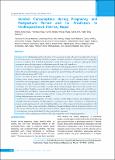Please use this identifier to cite or link to this item:
https://hdl.handle.net/20.500.14356/1681| Title: | Alcohol Consumption during Pregnancy and Postpartum Period and its Predictors in Sindhupalchowk District, Nepal |
| Authors: | Aryal, Krishna Kumar Thapa, Narbada Mehata, Suresh Thapa, Pushpa Alvik, Astrid Pedersen, Babill Stray |
| Citation: | AryalK. K., ThapaN., MehataS., ThapaP., AlvikA., & Stray-PedersenB. (2017). Alcohol Consumption during Pregnancy and Postpartum Period and its Predictors in Sindhupalchowk District, Nepal. Journal of Nepal Health Research Council, 14(3). https://doi.org/10.33314/jnhrc.v14i3.870 |
| Issue Date: | 2016 |
| Publisher: | Nepal Health Research Council |
| Article Type: | Original Article |
| Keywords: | Alcohol consumption Home brewed Nepal Postpartum period Pregnancy Predictor |
| Series/Report no.: | Sep-Dec, 2016;870 |
| Abstract: | Abstract Background: A substantial proportion of women in Nepal consume alcohol and homebrewed alcoholic beverages are the most common type of alcohol. Alcohol being a part of tradition and culture in Nepal and evidences suggesting even low to moderate dose of alcohol having impacts on the birth outcomes, we aimed at exploring the alcohol consumption pattern during pregnancy and postpartum period along with its predictors. Methods: We studied all pregnant and recently delivered women using quantitative methods in selected wards within selected Village Development Committees of Sindhupalchowk district in Nepal after purposively choosing the district. We present the findings on pregnancy and postpartum period drinking and its predictors as proportion and adjusted odds ratio along with 95% CI. Results: One-third of women drank alcohol during pregnancy and 43% during postpartum period. Nearly all drinking women mostly consumed homebrewed alcoholic beverages such as jaad/chhyang/localraksi. One-third consumed it daily during pregnancy, while three-quarters consumed daily during postpartum. One-fifth of currently drinking women drank ≥5 standard drinks on average per day in the last 30 days. Illiterate or women with low level of education were three times more likely to consume alcohol during pregnancy than women with secondary level education or higher. Similarly, women who didn’t know that alcohol during pregnancy affects mother and child were four and half times more likely to consume alcohol during pregnancy than those who knew about it. Also, being dalits, disadvantaged and janajatis, husband’s drinking and home brewing of alcohol were strongly associated with women’s drinking during pregnancy and postpartum period. Conclusions: A substantial proportion of women consumed alcohol during pregnancy and postpartum period with high consumption frequency. Findings suggested, increasing awareness about consequences of drinking during pregnancy and postpartum period would be helpful probably as one of the components of routine antenatal care with a special focus to ethnic groups such as dalits, disadvantaged janajatis including relatively advantaged janajatis as well as the women with lower levels of education. Culture sensitive behavior change communication interventions aimed at reducing home brewing and husband’s drinking would also be important Keywords: Alcohol consumption; home brewed; Nepal; postpartum period; pregnancy; predictor. |
| Description: | Original Article |
| URI: | http://103.69.126.140:8080/handle/20.500.14356/1681 |
| ISSN: | Print ISSN: 1727-5482; Online ISSN: 1999-6217 |
| Appears in Collections: | Vol. 14 No. 3 Issue 34 Sep-Dec 2016 |
Files in This Item:
| File | Description | Size | Format | |
|---|---|---|---|---|
| 870-Article Text-1659-2-10-20170528.pdf | Fulltext Download. | 295.42 kB | Adobe PDF |  View/Open |
Items in DSpace are protected by copyright, with all rights reserved, unless otherwise indicated.
